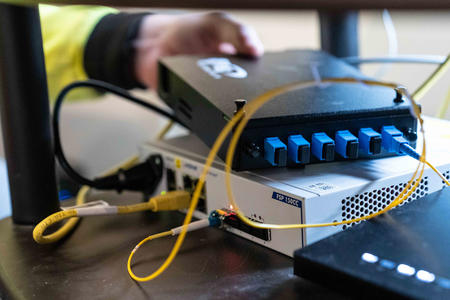Kwolek was one of 34 Crosscut readers who responded to a recent story about the new national broadband map produced by the Federal Communications Commission (FCC). Like many who wrote in, she felt the map overstated the paltry internet options in her community.
That’s a sentiment she shares with at least 1 million Americans, according to early results of an effort to shore up the country’s spotty data on connectivity. In Washington state, county officials say tens of thousands of households in the Puget Sound area alone appear wrongly designated as fully served by broadband services.
In 2020, Congress tasked the FCC with updating its national internet connectivity data, which for decades has been regarded as vastly understating the number of Americans without internet access. (The FCC says 14.5 million Americans remain offline; an alternative tally by Microsoft argues the number is as high as 120 million.)
Many had hoped that process would be further along by this year, as it will shape how a $42 billion infrastructure push – the largest single investment in the nation’s broadband network – gets distributed among states this July.
This story is a part of Crosscut’s WA Recovery Watch, an investigative project tracking federal dollars in Washington state.
The FCC released updated maps, largely based on service data self-reported by telecom companies, on Nov. 18. But a Jan. 13 deadline to object left less than two months (over the holiday season) for states, local governments and individuals to submit challenges to the service levels outlined for their areas.
Asked in December if the short deadline would result in less accurate data, FCC Chair Jessica Rosenworcel replied that the Jan. 13 deadline was set by a different agency, the National Telecommunications and Information Administration (NTIA).
“That’s not a date that’s in our rules in any way, shape, and form,” Rosenworcel said. “It’s just a target that was set by my colleagues at the NTIA to try to ensure that as many challenges get resolved as possible before our production of the next map.”
In their own statement, the NTIA did not directly address concerns about map accuracy, instead arguing that pushing back the deadline would further delay the much-needed resources. The NTIA noted that more than 1 million challenges had already been submitted to the FCC.
“Unfortunately, a delay in the timeline would mean a delay in providing funding to communities who desperately need it, and it will not address many of the process concerns we have heard.”
The FCC has had more than two years to sharpen its maps since Congress passed the Broadband Data Act, which required it to collect more granular data and allow for input from web users. Historically, the agency’s reliance on companies to self-report what census blocks they serve with minimal vetting has produced highly flawed maps, according to critics.
As part of this process, Washington officials have identified thousands of locations with incorrect internet service information.
Pierce County challenged some 10,000 locations on the FCC’s map, where they believe companies are wrongly claiming to provide internet service. In 2020, the county hired a consultant to gather data on unserved parts of the county as part of a plan to create five “broadband incentive districts” on the county’s unincorporated periphery. That work found at least 14,000 unserved homes, according to Jon Baker, project manager for Pierce County’s broadband initiatives.
The FCC also missed about 40% of the 5,220 unserved homes identified by King County in a 2020 broadband access study, according to the office of county council member Sarah Perry. That data was submitted to the FCC in early January, but was rejected one week later, according to Tommy Lee, a manager for King County’s IT department.
Lee wrote in an email that the FCC’s response took issue with King County's methodology, arguing it "does not connect how the study’s information correlates to the speeds offered by the indicated companies at the challenged locations."
And in Snohomish County, officials said an additional 7,400 households are missing from the map entirely. Those numbers come from comparing county assessor, planning and 911 data with the FCC’s map data, according to Jason Biermann, senior policy advisor to the Snohomish County Executive's Office. It’s unclear if those homes are served or not.
“Right now, we believe Snohomish County’s broadband access is likely significantly overrepresented, particularly in rural areas,” Biermann wrote in an email.
The county encouraged residents to file challenges with the FCC, but did not submit any official challenge by the Jan. 13 deadline. Biermann said the FCC did not provide enough time for that.
“The FCC’s compressed timeline, coupled with the fact that the challenge period took place during the holidays and — occasionally — during severe winter weather, meant that more comprehensive outreach wasn’t feasible,” he wrote.
(Snohomish County does plan to challenge, Biermann added, once they can verify how many of those homes are unserved.)
Find tools and resources in Crosscut’s Follow the Funds guide to track down federal recovery spending in your community.
Washington’s state broadband office asked residents to file their own challenges, although it’s not clear what effect that had. (The office’s director, Mark Vasconi, did not make himself available for comment last week.) Web users could also submit challenges through a portal hosted by Washington State University Extension. That effort yielded just 40 responses, according to Dustin Loup, Broadband and Digital Equity project director.
Loup, who also heads the National Broadband Mapping Coalition, was skeptical that a quick fix to the map’s long-standing accuracy issues would be possible on such a short timeframe. The FCC’s process is not particularly user-friendly and places a disproportionate burden on individuals with the least resources to fix the problem, he said.
“There’s this obvious oxymoron here with requiring people who don’t have the internet to challenge [companies] who are saying that they provide that internet to them," Loup said. “Even in the best scenario, it’s stacked against the unserved individuals."
The impact of service challenges or updated data on federal funding may not be known until July, when final allocations go out to states. But the FCC is continuing to accept challenges, and Loup said individuals should continue to file them, because they may affect what areas are eligible to receive money.
“Last week’s deadline affected the size of the pool,” Loup said, “not necessarily who gets to swim in it.”
A number of Crosscut readers from across the state shared their ongoing frustrations with limited or nonexistent internet access. One reader in Brinnon, a tiny village along the Olympic Peninsula, wrote in to say his home does not appear on the map at all.
“What I see is lots of green dots in the neighborhood, which are my neighbors, but none at my geo-location or address,” the Brinnon reader wrote. “Our neighborhood is sparse enough that I know I am missing.”






